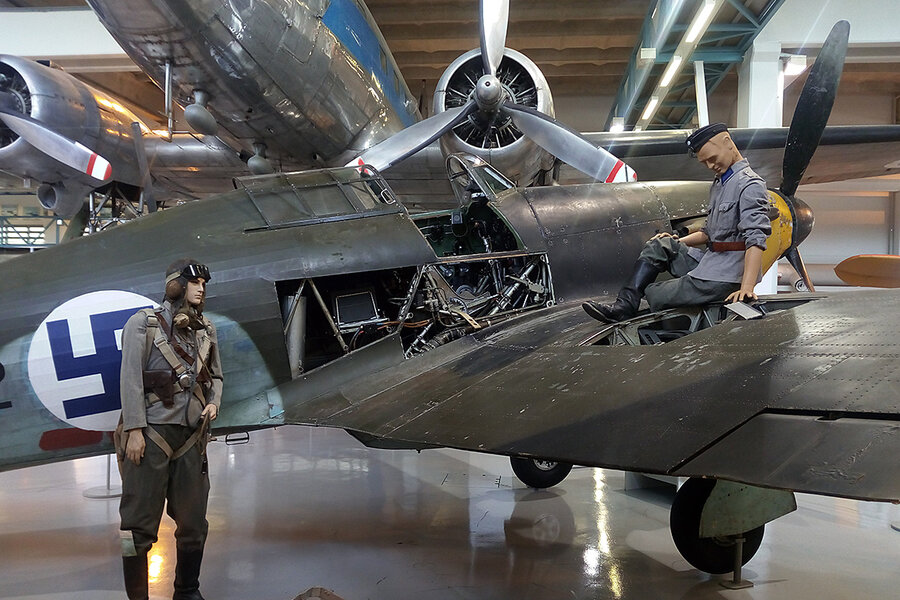Finland used the swastika before the Nazis. Why do they still?
Loading...
| Jyväskylä, Finland
Teivo Teivainen, a professor at the University of Helsinki, often finds himself explaining the numerous swastikas on wartime monuments around the Finnish capital to baffled foreign students. The Finnish swastika pre-dated Germany's Nazi Party. The historically innocuous symbol was introduced to the Finnish military in 1918 during the country’s civil war and became the emblem of the Finnish Air Force. While it no longer appears on Finnish aircraft, the service uses it to this day. For Finns like Professor Teivainen, this is worrisome, especially at a time when a conflict with Russia doesn’t seem far-fetched. Should war break out, he says, Finland would be forced to turn to their NATO partners. “How do you think people in the German parliament or French cabinet or the Dutch general public, for whom the swastika means only one thing, might feel?” But for most Finns, their swastika doesn’t need changing, says Eddy Hawkins, an American journalist who has studied the subject. “It’s perceived as different: a different symbol from that which was used by the Nazis, a different history and a different meaning.”
Why We Wrote This
The symbols we choose to represent ourselves are always laden with meaning. But when a symbol we legitimately see as virtuous is fairly viewed by everyone else as villainous, should we make a change?
When guests, particularly foreigners, enter the soaring hangar of the Finnish Air Force Museum and find themselves confronted by a menagerie of aircraft adorned with swastikas, they are often taken aback.
“We hasten to explain to visitors, our swastika has nothing to do with the Nazi swastika,” says Kai Mecklin, museum director and a former pilot in the Finnish Air Force (FAF). “The Finnish Air Force adopted the swastika as its logo long before Hitler and the Nazis did.”
And while the FAF’s practice of putting swastikas on its aircraft ended decades ago, it is still easy enough to find swastikas on FAF shoulder badges and at the Finnish Air Force Academy.
Why We Wrote This
The symbols we choose to represent ourselves are always laden with meaning. But when a symbol we legitimately see as virtuous is fairly viewed by everyone else as villainous, should we make a change?
For Mr. Mecklin, like many Finns, that is as it should be. “To us the swastika is a symbol of freedom and independence,” he says. But some see the persistence of the swastika in Finnish culture as problematic, particularly with Finland situated between two regions for whom the swastika symbolizes not freedom, but its Nazi opposite. And as Finland’s far right becomes increasingly restive, it could force Finns to change the way they consider the symbol’s place in their modern society.
Finland’s adoption of the swastika predates its association with National Socialism. Mecklin tells the tale of how in 1918, the Swedish count Eric von Rosen had a swastika painted on the wings of an aircraft which he donated to the Finnish White Army, which was then fighting against Soviet-backed Red Guards to establish an independent Finland – a battle which the Whites ultimately won.
The swastika became the official symbol of the Finnish Air Force, and remained so until Finland and the Soviet Union – which had just fought a successful war with the United States to eradicate Nazidom – signed a postwar armistice. As part of the new relationship it was understood that Finnish military aircraft would no longer carry the swastika.
But the swastika can still be found in the emblem of the FAF and at least one Finnish army unit today. And Teivo Teivainen, a professor at the University of Helsinki who often finds himself explaining the numerous swastikas on wartime monuments around the Finnish capital to baffled foreign students, argues that needs to change.
What particularly bothers Professor Teivainen is how the armed forces’ continued use of the swastika could create difficulties for Finland if and when a war breaks out with Russia, and Finland is forced to turn to their NATO partners. “How do you think people in the German parliament or French cabinet or the Dutch general public, for whom the swastika means only one thing, might feel?” he asks.
“Let’s say a decision needs to be made very quickly in, say, a Dutch cabinet meeting, and someone flashes a picture of the swastika as the official Air Force symbol of Finland, would this be likely to increase the Netherlands’ kinship with us?” says Teivainen. “There’s always the chance it will send the wrong signal.”
The question of when, where, and how the swastika should be seen in public has become more sensitive with the rise of a small, but increasingly vociferous, right-wing movement in Finland.
Spearheaded by the so-called Finnish Resistance Movement, which the government is currently seeking to ban, the Finnish far right does not use the swastika as its logo. But there’s always the chance that a swastika pops up at a movement rally. If that happens, the question of the Finnish armed forces’ use of the same symbol as Hitler’s Nazis – even if the Germans adopted it later, in the 1920s – could become an explosive one.
Finnish aviation historian Carl-Fredrik Geust writes that such concerns are overblown. “The reason why we still have our FINNISH swastikas in use – and very limited use, mind you – is due to our unique respect for historical traditions and memories – and not just our own.” He points out that even though Finns in general have no love lost for Russia, Russian tourists are still astonished to find a statue of Czar Alexander II in Helsinki’s Senate Square.
“Tradition means something to us,” writes Mr. Geust.
He also points out that the swastika has been used as an ornament and magical symbol since ancient times, and that many Western countries used it as a symbol of good luck during the beginning of the 20th century. It was for that reason that von Rosen, who many consider the godfather of the Finnish Air Force, decided to paint the swastika on the plane he gave to the Finns.
(While von Rosen’s introduction of the swastika to Finland had no relation to National Socialism, van Rosen himself in later years did. In 1923, his sister married Hermann Göring, and he had ties to Swedish national socialist parties in the 1930s.)
Whether the swastika brings the Finnish Air Force, which celebrated its centenary this year, good luck or controversy remains to be seen.
In the meantime, as far as Finnish authorities are concerned, the question is a closed one. “At present time the Ministry of Defense has no plans to restrict or review the use of the swastika,” says Kristian Vakkuri, the ministry spokesperson.
The same, it would seem, goes for the Finnish people. “If they think about it, or are asked about the swastika, it’s perceived as different: a different symbol from that which was used by the Nazis, a different history and a different meaning,” says Eddy Hawkins, an American journalist who has studied the subject. “But most people don’t think about it.”
Maybe they ought to, says Teivainen.








